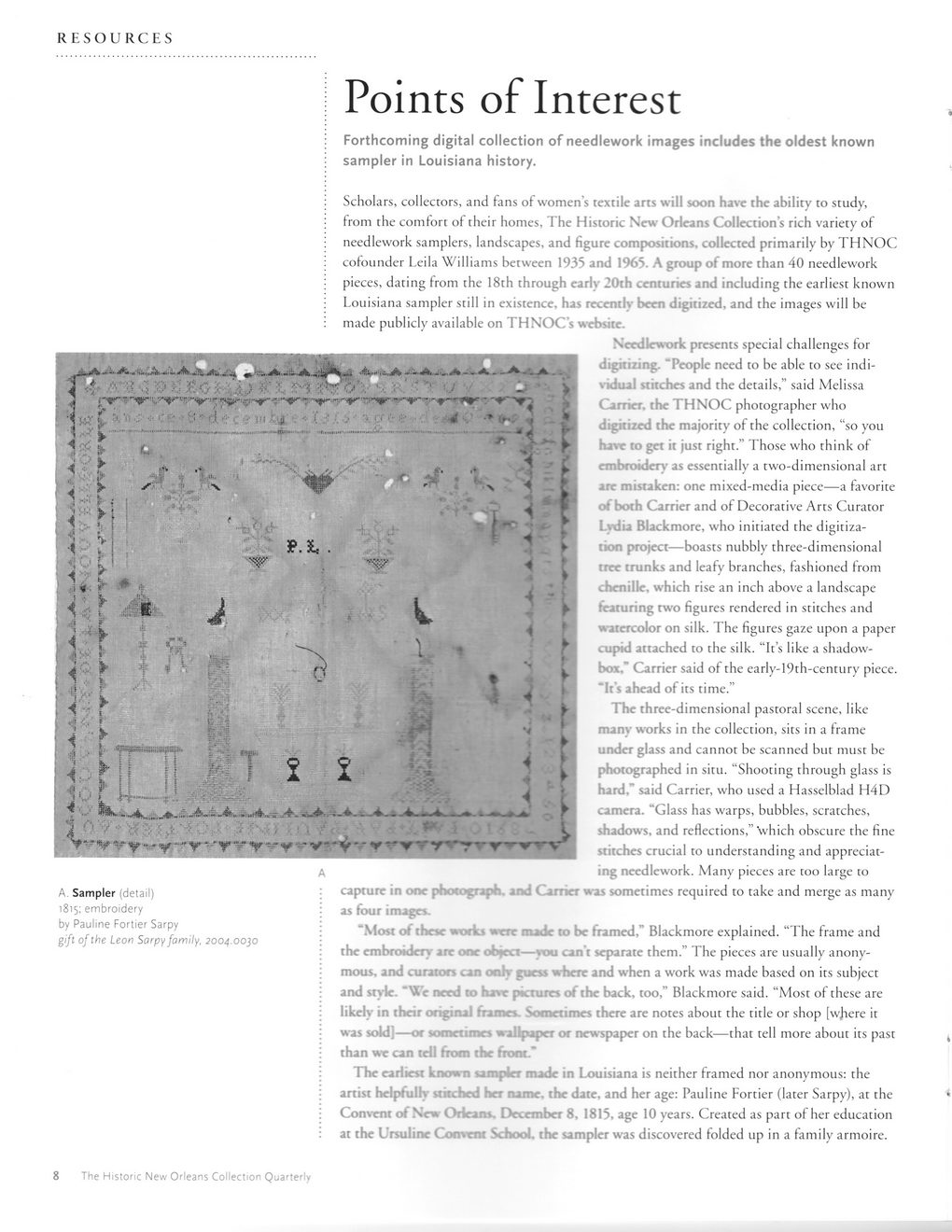This text was obtained via automated optical character recognition.
It has not been edited and may therefore contain several errors.
RESOURCES Points of Interest Forthcoming digital collection of needlework images includes the oldest known sampler in Louisiana history. *; ¥ "••• *:vi , . . (iU.jfcl -.V-.kA,.* r- A. Sampler (detail) 1815; embroidery by Pauline Fortier Sarpy gift of the Leon Sarpy family, 2004.0030 Scholars, collectors, and fans of women’s textile arts will soon have the ability to study, from the comfort of their homes, The Historic New Orleans Collection’s rich variety of needlework samplers, landscapes, and figure compositions, collected primarily by THNOC cofounder Leila Williams between 1935 and 1965- A group of more than 40 needlework pieces, dating from the 18th through early 20ih centuries and including the earliest known Louisiana sampler still in existence, has recently been digitized, and the images will be made publicly available on THNOCs website. Needlework presents special challenges for digitizing. "People need to be able to see individual stitches and the details,” said Melissa Carrier, the THNOC photographer who digitized the majority of the collection, “so you have to get it just right.” Those who think of embroidery as essentially a two-dimensional art are mistaken: one mixed-media piece—a favorite of both Carrier and of Decorative Arts Curator Lydia Blackmore, who initiated the digitization project—boasts nubbly three-dimensional tree trunks and leafy branches, fashioned from chenille, which rise an inch above a landscape featuring two figures rendered in stitches and watercolor on silk. The figures gaze upon a paper cupid attached to the silk. “It’s like a shadow-box," Carrier said of the early-19th-centurv piece. "“It’s ahead of its time.” The three-dimensional pastoral scene, like many works in the collection, sits in a frame under glass and cannot be scanned but must be photographed in situ. “Shooting through glass is hard,” said Carrier, who used a Hasselblad H4D camera. “Glass has warps, bubbles, scratches, shadows, and reflections,” "which obscure the fine stitches crucial to understanding and appreciating needlework. Many pieces are too large to capture in one photograph. ? -J Carrier was sometimes required to take and merge as many as flour images. “Most of these works were to be framed,” Blackmore explained. “The frame and the embroidery are one object—w»u can’t separate them.” The pieces are usually anonymous, and curators can only guess where and when a work was made based on its subject and style. *We need to hive pictures of the back, too,” Blackmore said. “Most of these are likely in their original frames. Sometimes there are notes about the title or shop [where it was sold)—or sometimes w*n—r<eT or newspaper on the back—that tell more about its past than we can tel) from the frooc." The earliest known samptcT made in Louisiana is neither framed nor anonymous: the artist helpfully stitched her name, the date, and her age: Pauline Fortier (later Sarpy), at the Convent of New Oricam. December 8, 1815, age 10 years. Created as part of her education at the Ursuline Convent School, the sampler was discovered folded up in a family armoire. 8 The Historic New Orleans Collection Quarterly

New Orleans Quarterly 2015 Fall (10)